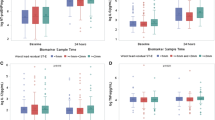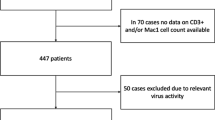Abstract
Coronary plaque rupture is associated with a systemic inflammatory response. The relationship between baseline N-terminal pro B-type natriuretic peptide (NT-proBNP), a prognostic marker in patients with acute coronary syndromes, and systemic inflammatory mediators in patients with ST-segment elevation myocardial infarction (STEMI) treated with primary percutaneous coronary intervention (PCI) is not well described. Of 5,745 STEMI patients treated with primary PCI in the APEX-AMI trial, we evaluated the relationship between baseline NT-proBNP levels and baseline levels of inflammatory markers and markers of myonecrosis in a subset of 772 who were enrolled in a biomarker substudy. Spearman correlations (r s) were calculated between baseline NT-proBNP levels and a panel of ten systemic inflammatory biomarkers. Interleukin (IL)-6, a pro-inflammatory cytokine, was significantly positively correlated with NT-proBNP (r s = 0.317, P < 0.001). In a sensitivity analysis excluding all heart failure patients, the correlation between baseline IL-6 and NT-proBNP remained significant (n = 651, r s = 0.296, P < 0.001). A positive association was also observed with high sensitivity C-reactive protein (r s = 0.377, P < 0.001) and there was a weak negative correlation with the anti-inflammatory cytokine IL-10 (r s = −0.109, P = 0.003). No other significant correlations were observed among the other testes inflammatory cytokines and chemokines. In STEMI patients undergoing primary PCI, the pro-inflammatory cytokine IL-6 was modestly correlated with baseline NT-proBNP levels. This relationship remained significant in patients without heart failure. This finding is consistent with pre-clinical and clinical research suggesting that systemic inflammation may influence NT-proBNP expression independently of myocardial stretch.

Similar content being viewed by others
References
de Lemos JA, Morrow DA, Bentley JH, Omland T, Sabatine MS, McCabe CH, Hall C, Cannon CP, Braunwald E (2001) The prognostic value of B-type natriuretic peptide in patients with acute coronary syndromes. N Engl J Med 345(14):1014–1021. doi:10.1056/NEJMoa011053
Sabatine MS, Morrow DA, de Lemos JA, Gibson CM, Murphy SA, Rifai N, McCabe C, Antman EM, Cannon CP, Braunwald E (2002) Multimarker approach to risk stratification in non-ST elevation acute coronary syndromes. Circulation 105(15):1760–1763. doi:10.1161/01.cir.0000015464.18023.0a
Richards AM, Nicholls MG, Espiner EA, Lainchbury JG, Troughton RW, Elliott J, Frampton C, Turner J, Crozier IG, Yandle TG (2003) B-type natriuretic peptides and ejection fraction for prognosis after myocardial infarction. Circulation 107(22):2786–2792. doi:10.1161/01.cir.0000070953.76250.b9
Mega JL, Morrow DA, De Lemos JA, Sabatine MS, Murphy SA, Rifai N, Gibson CM, Antman EM, Braunwald E (2004) B-type natriuretic peptide at presentation and prognosis in patients with ST-segment elevation myocardial infarction: an ENTIRE-TIMI-23 substudy. J Am Coll Cardiol 44(2):335–339
Grabowski M, Filipiak KJ, Malek LA, Karpinski G, Huczek Z, Stolarz P, Spiewak M, Kochman J, Rudowski R, Opolski G (2007) Admission B-type natriuretic peptide assessment improves early risk stratification by Killip classes and TIMI risk score in patients with acute ST elevation myocardial infarction treated with primary angioplasty. Int J Cardiol 115(3):386–390
Damman P, Beijk MAM, Kuijt WJ, Verouden NJW, van Geloven N, Henriques JPS, Baan J, Vis MM, Meuwissen M, van Straalen JP, Fischer J, Koch KT, Piek JJ, Tijssen JGP, de Winter RJ (2011) Multiple biomarkers at admission significantly improve the prediction of mortality in patients undergoing primary percutaneous coronary intervention for acute ST-segment elevation myocardial infarction. J Am Coll Cardiol 57(1):29–36
James SK, Lindahl B, Siegbahn A, Stridsberg M, Venge P, Armstrong P, Barnathan ES, Califf R, Topol EJ, Simoons ML, Wallentin L (2003) N-terminal pro-brain natriuretic peptide and other risk markers for the separate prediction of mortality and subsequent myocardial infarction in patients with unstable coronary artery disease. Circulation 108(3):275–281. doi:10.1161/01.cir.0000079170.10579.dc
Herskowitz A, Choi S, Ansari AA, Wesselingh S (1995) Cytokine mRNA expression in postischemic/reperfused myocardium. Am J Pathol 146(2):419–428
Pannitteri G, Marino B, Campa PP, Martucci R, Testa U, Peschle C (1997) Interleukins 6 and 8 as mediators of acute phase response in acute myocardial infarction. Am J Cardiol 80(5):622–625
Smith DA, Irving SD, Sheldon J, Cole D, Kaski JC (2001) Serum levels of the antiinflammatory cytokine interleukin-10 are decreased in patients with unstable angina. Circulation 104(7):746–749. doi:10.1161/hc3201.094973
Deten A, Volz HC, Briest W, Zimmer H-G (2002) Cardiac cytokine expression is upregulated in the acute phase after myocardial infarction. Experimental studies in rats. Cardiovasc Res 55(2):329–340
Nian M, Lee P, Khaper N, Liu P (2004) Inflammatory cytokines and postmyocardial infarction remodeling. Circ Res 94(12):1543–1553
Koten K, Hirohata S, Miyoshi T, Ogawa H, Usui S, Shinohata R, Iwamoto M, Kitawaki T, Kusachi S, Sakaguchi K, Ohe T (2008) Serum interferon-gamma-inducible protein 10 level was increased in myocardial infarction patients, and negatively correlated with infarct size. Clin Biochem 41(1–2):30–37
Kinnunen P, Vuolteenaho O, Ruskoaho H (1993) Mechanisms of atrial and brain natriuretic peptide release from rat ventricular myocardium: effect of stretching. Endocrinology 132(5):1961–1970. doi:10.1210/en.132.5.1961
Ma KK, Ogawa T, de Bold AJ (2004) Selective upregulation of cardiac brain natriuretic peptide at the transcriptional and translational levels by pro-inflammatory cytokines and by conditioned medium derived from mixed lymphocyte reactions via p38 MAP kinase. J Mol Cell Cardiol 36(4):505–513. doi:10.1016/j.yjmcc.2004.01.001
Tanaka T, Kanda T, Takahashi T, Saegusa S, Moriya J, Kurabayashi M (2004) Interleukin-6-induced reciprocal expression of SERCA and natriuretic peptides mRNA in cultured rat ventricular myocytes. J Int Med Res 32(1):57–61
Kuwahara K, Saito Y, Ogawa Y, Tamura N, Ishikawa M, Harada M, Ogawa E, Miyamoto Y, Hamanaka I, Kamitani S, Kajiyama N, Takahashi N, Nakagawa O, Masuda I, Nakao K (1998) Endothelin-1 and cardiotrophin-1 induce brain natriuretic peptide expression by distinct transcriptional mechanisms. J Cardiovasc Pharmacol 31:S354–S356
Maeder M, Ammann P, Kiowski W, Rickli H (2005) B-type natriuretic peptide in patients with sepsis and preserved left ventricular ejection fraction. Eur J Heart Fail 7(7):1164–1167. doi:10.1016/j.ejheart.2005.03.003
Papp A, Uusaro A, Parviainen I, Hartikainen J, Ruokonen E (2003) Myocardial function and haemodynamics in extensive burn trauma: evaluation by clinical signs, invasive monitoring, echocardiography and cytokine concentrations. A prospective clinical study. Acta Anaesthesiol Scand 47(10):1257–1263. doi:10.1046/j.1399-6576.2003.00235.x
Heeschen C, Dimmeler S, Hamm CW, Fichtlscherer S, Boersma E, Simoons ML, Zeiher AM, Investigators CS (2003) Serum level of the antiinflammatory cytokine interleukin-10 is an important prognostic determinant in patients with acute coronary syndromes. Circulation 107(16):2109–2114
Chiurchiù V, Izzi V, D’Aquilio F, Carotenuto F, Di Nardo P, Baldini PM (2008) Brain natriuretic peptide (BNP) regulates the production of inflammatory mediators in human THP-1 macrophages. Regul Pept 148(1–3):26–32. doi:10.1016/j.regpep.2008.02.009
Armstrong PW, Adams PX, Al-Khalidi HR, Hamm C, Holmes D, O’Neill W, Todaro TG, Vahanian A, Van de Werf F, Granger CB (2005) Assessment of pexelizumab in acute myocardial infarction (APEX AMI): a multicenter, randomized, double-blind, parallel-group, placebo-controlled study of pexelizumab in patients with acute myocardial infarction undergoing primary percutaneous coronary intervention. Am Heart J 149(3):402–407. doi:10.1016/j.ahj.2004.12.015
The APEX-AMI investigators (2007) Pexelizumab for acute ST-elevation myocardial infarction in patients undergoing primary percutaneous coronary intervention. JAMA 297(1):43–51. doi:10.1001/jama.297.1.43
Mahaffey KW, Reist CJ, Fu Y, Brener SJ, Theroux P, Patel MR, Stebbins A, Westerhout CM, Todaro TG, Adams PX, Granger CB, Armstrong PW (2008) Integrating ancillary studies in a large clinical trial: the design and rationale of the APEX library. Contemp Clin Trials 29(6):887–895. doi:10.1016/j.cct.2008.06.003
Ezekowitz JA, Armstrong PW, Granger CB, Theroux P, Stebbins A, Kim RJ, Patel MR (2010) Predicting chronic left ventricular dysfunction 90 days after ST-segment elevation myocardial infarction: an assessment of pexelizumab in acute myocardial infarction (APEX-AMI) substudy. Am Heart J 160(2):272–278. doi:10.1016/j.ahj.2010.05.035
Buller CE, Fu Y, Mahaffey KW, Todaro TG, Adams P, Westerhout CM, White HD, van’t Hof AWJ, Van de Werf FJ, Wagner GS, Granger CB, Armstrong PW (2008) ST-segment recovery and outcome after primary percutaneous coronary intervention for ST-elevation myocardial infarction. Circulation 118(13):1335–1346. doi:10.1161/circulationaha.108.767772
Januzzi JL, van Kimmenade R, Lainchbury J, Bayes-Genis A, Ordonez-Llanos J, Santalo-Bel M, Pinto YM, Richards M (2006) NT-proBNP testing for diagnosis and short-term prognosis in acute destabilized heart failure: an international pooled analysis of 1,256 patients. Eur Heart J 27(3):330–337. doi:10.1093/eurheartj/ehi631
Zile MR, Gaasch WH, Carroll JD, Feldman MD, Aurigemma GP, Schaer GL, Ghali JK, Liebson PR (2001) Heart failure with a normal ejection fraction. Circulation 104(7):779–782. doi:10.1161/hc3201.09422629
Tateishi J, Masutani M, Ohyanagi M, Iwasaki T (2000) Transient increase in plasma brain (B-type) natriuretic peptide after percutaneous transluminal coronary angioplasty. Clin Cardiol 23(10):776–780. doi:10.1002/clc.4960231016
Pan J, Fukuda K, Saito M, Matsuzaki J, Kodama H, Sano M, Takahashi T, Kato T, Ogawa S (1999) Mechanical stretch activates the JAK/STAT pathway in rat cardiomyocytes. Circ Res 84(10):1127–1136
Tsutamoto T, Hisanaga T, Wada A, Maeda K, Ohnishi M, Fukai D, Mabuchi N, Sawaki M, Kinoshita M (1998) Interleukin-6 spillover in the peripheral circulation increases with the severity of heart failure, and the high plasma level of interleukin-6 is an important prognostic predictor in patients with congestive heart failure. J Am Coll Cardiol 31(2):391–398. doi:10.1016/s0735-1097(97)00494-4
Maisel AS, Krishnaswamy P, Nowak RM, McCord J, Hollander JE, Duc P, Omland T, Storrow AB, Abraham WT, Wu AHB, Clopton P, Steg PG, Westheim A, Knudsen CW, Perez A, Kazanegra R, Herrmann HC, McCullough PA (2002) Rapid measurement of B-type natriuretic peptide in the emergency diagnosis of heart failure. N Engl J Med 347(3):161–167. doi:10.1056/NEJMoa020233
Wang P, Wu P, Siegel MI, Egan RW, Billah MM (1995) Interleukin (IL)-10 inhibits nuclear factor B (NFB) activation in human monocytes. J Biol Chem 270(16):9558–9563. doi:10.1074/jbc.270.16.9558
Lacraz S, Nicod LP, Chicheportiche R, Welgus HG, Dayer JM (1995) IL-10 inhibits metalloproteinase and stimulates TIMP-1 production in human mononuclear phagocytes. J Clin Invest 96(5):2304–2310
Waehre T, Halvorsen B, Damas JK, Yndestad A, Brosstad F, Gullestad L, Kjekshus J, Froland SS, Aukrust P (2002) Inflammatory imbalance between IL-10 and TNF-alpha in unstable angina potential plaque stabilizing effects of IL-10. Eur J Clin Invest 32(11):803–810
Stumpf C, Lehner C, Yilmaz A, Daniel WG, Garlichs CD (2003) Decrease of serum levels of the anti-inflammatory cytokine interleukin-10 in patients with advanced chronic heart failure. Clin Sci 105(1):45–50. doi:10.1042/cs20020359
Lopes RD, Batista ML, Rosa JC, Lira FS, Martins EJ, Shimura AY, Brum PC, Lancha AH, Seelaender MC, Lopes AC (2010) Changes in the production of IL-10 and TNF-alpha in skeletal muscle of rats with heart failure secondary to acute myocardial infarction. Arq Bras Cardiol 94(3):293–300
Grabowski M, Filipiak KJ, Karpinski G, Wretowski D, Rdzanek A, Huczek Z, Horszczaruk GJ, Kochman J, Rudowski R, Opolski G (2004) Serum B-type natriuretic peptide levels on admission predict not only short-term death but also angiographic success of procedure in patients with acute ST-elevation myocardial infarction treated with primary angioplasty. Am Heart J 148(4):655–662. doi:10.1016/j.ahj.2004.04.023
Gill D, Seidler T, Troughton RW, Yandle TG, Frampton CM, Richards M, Lainchbury JG, Nicholls G (2004) Vigorous response in plasma N-terminal pro-brain natriuretic peptide (NT-BNP) to acute myocardial infarction. Clin Sci 106(2):135–139. doi:10.1042/cs20030131
Anwaruddin S, Lloyd-Jones DM, Baggish A, Chen A, Krauser D, Tung R, Chae C, Januzzi JL Jr (2006) Renal function, congestive heart failure, and amino-terminal pro-brain natriuretic peptide measurement: results from the proBNP investigation of dyspnea in the emergency department (PRIDE) study. J Am Coll Cardiol 47(1):91–97. doi:10.1016/j.jacc.2005.08.051
Acknowledgments
The APEX-AMI trial from which this work was derived, was supported by a research grant jointly funded from Procter & Gamble and Alexion Pharmaceuticals.
Author information
Authors and Affiliations
Corresponding author
Additional information
This study was conducted on behalf of the APEX-AMI investigators.
Rights and permissions
About this article
Cite this article
van Diepen, S., Roe, M.T., Lopes, R.D. et al. Baseline NT-proBNP and biomarkers of inflammation and necrosis in patients with ST-segment elevation myocardial infarction: insights from the APEX-AMI trial. J Thromb Thrombolysis 34, 106–113 (2012). https://doi.org/10.1007/s11239-012-0691-0
Published:
Issue Date:
DOI: https://doi.org/10.1007/s11239-012-0691-0




